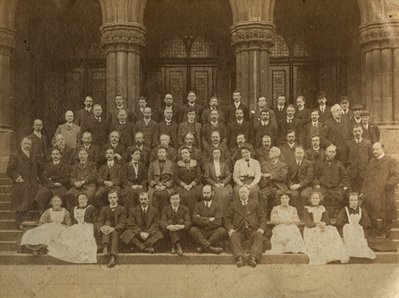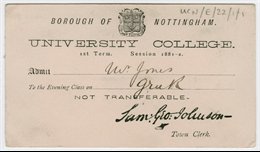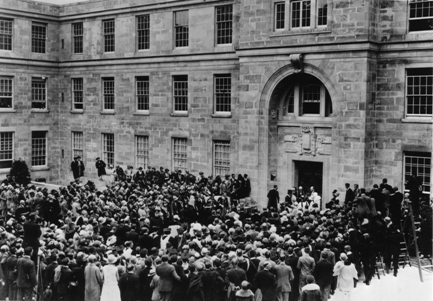University College History
Founding and Early Years
University College Nottingham was founded in 1877. The College grew out of the 19th century desire to open up university education to people unable to attend the traditional universities of Oxford or Cambridge. The actual impetus for the building of the college was a grant of £10,000 by an anonymous donor to Nottingham Corporation, to provide an endowment for lectureships. The donation was given on the condition that the Corporation acquired or built suitable accommodation for the lectures.
Building work began on the new college buildings in 1877. The site chosen was a parcel of land known as Horse Pool Close which was already owned by the Corporation. Shakespeare Street had been built across the close in 1852. The foundation stone of the new college buildings was laid on 27th September 1877 and the college opened in 1881. Classes began in autumn 1881.

Photograph of staff outside Shakespeare Street buildings. (UCN/P/8/1)
The College opened in 1881 with a staff of four professors, six lecturers and twelve teachers and a student body of 381 day students, 623 evening students and 346 members of government science classes. Classes were offered in the arts, humanities and sciences with lecturers expected to cover more than one subject, rather than the specialism known today. From its beginning the aim of the College was to bring education to all those who desired it, regardless of class, sex or financial means. To ensure that workers were able to share in the educational opportunities offered by the College, many classes had to be held in the evening. These evening classes became an increasing burden on the College over time as the more academic side of its work grew, but they were maintained whilst the College remained on the Shakespeare Street site.

Ticket for first class at Shakespeare Street (UCN/E/22/1).
In its early years the College offered what we would nowadays think of as secondary or further education rather than higher education. The reason for this was that compulsory education ended at age 13, with no provision for secondary education being made until the Balfour Act of 1902. Students leaving school at thirteen were therefore ill-equipped to enter into a real university-style academic education. The majority of the early College students, who were admitted at age 14 upwards, attended ‘university-extension classes’. These classes offered the type of material that would now be covered in the later years of secondary school. The completion of such a course (consisting of 11 lectures and 10 classes) and the passing of an exam resulted in a certificate from the University of Cambridge.
University College, Nottingham had no powers of its own to confer degrees, instead allowing matriculation to the universities of Cambridge and Oxford (though in practice this rarely happened). The College later aligned itself with the University of London which offered external degree courses. This affiliation allowed University College students to study to degree level, with the first B.A. being awarded in 1884.
Growth
Attendance at the College rose steadily, if slowly, for the first twenty-five years of its existence. The slowest growth was seen in the number of day students, due to the inability of workers to attend classes in the day-time and the failure of the middle classes to make full use of the College. By the 1903-04 session, twenty-one years after the opening of the College, the number of day students had reached 488 whilst the number of evening students had risen to 1, 715. This expansion in the number of students was both a cause and result of an increase in the number of staff and courses. Significant developments included the introduction of classes to train elementary teachers, which eventually resulted in the establishment of Nottingham as a day training college in 1890, and the introduction of engineering and technical classes, which led to the opening of new buildings behind the original College in 1893. Other developments included the establishment of lectures in coal mining and the opening of the Midland Dairy Institute at Kingston on Soar.
After a period of inertia in the early 1900s the administration of the College was reorganised, resulting in the creation of several new chairs, such as History, and the purchase or lease of new buildings such as the Hylton House hostel in Raleigh Street for female students. The more elementary academic work was abandoned and the admission age raised to sixteen.
Move from Shakespeare Street
As the College grew it became increasingly apparent that the Shakespeare Street buildings were no longer adequate to meet the needs of the College. Lack of space meant that classes were crammed into basement rooms and attics never designed for that purpose. The influx of new students after the First World War exacerbated the problem with the number of day students alone jumping from 509 in 1918-19 to 1,011 in 1921. It was clear that new accommodation was going to have to be found if the College was to continue to grow and thrive. At the same time there was agitation among members of the College governing body for the College to be granted full University status. These two needs combined in 1920 when Sir Jesse Boot (later Lord Trent) made the first of a number of significant gifts to the University College. Over the following years he gave land at Highfields in Nottingham for the site of a new ‘East Midlands University’ and donated money towards the new buildings. Though the hope of establishing an East Midlands University was abandoned, Sir Jesse Boot’s donations of land and money proved a significant step towards the creation of a Nottingham University.
Work began on the new University College buildings (the present University Park campus) in 1922 on land donated by Sir Jesse Boot. The new college campus was officially opened on 10th July 1928 by King George V and Queen Mary. From this point on the majority of departments were housed on the new campus although some, such as engineering, remained at Shakespeare Street until 1946.

Official opening of University Park campus, 10th July 1928. (UR 1383/1)
University Status
The idea of converting Nottingham University College into a full University was mooted early in its history. In 1906 a report by the Senate of the College expressed the desirability of the College acquiring full University status. A concerted effort was made in 1928 to gain the College its Royal charter (the recognised way to establish a new University). In order to be granted University status the College needed to show that it had the support of the local community in the form of endowments. An endowment appeal was launched in 1928 to coincide with the opening of the new college buildings. The appeal aimed at raising £250, 000. Despite the large amounts of money donated by Sir Jesse Boot and other benefactors, the endowment appeal fell short of raising the money needed.
As well as the lack of financial support, one of the reasons behind the delay in obtaining University status was the indecision as to whether the University College should apply for University status in its own right, or in conjunction with other colleges such as Leicester as part of a larger ‘East Midlands University’. A number of conferences were held on the subject of the proposed East Midlands University but the plan ultimately came to nothing.
It was in 1948 that Nottingham University College was finally granted its university charter, 71 years after it was founded. The College was renamed the University of Nottingham and was able to confer its own degrees.
Next page: Role of philanthropy in the history of University College